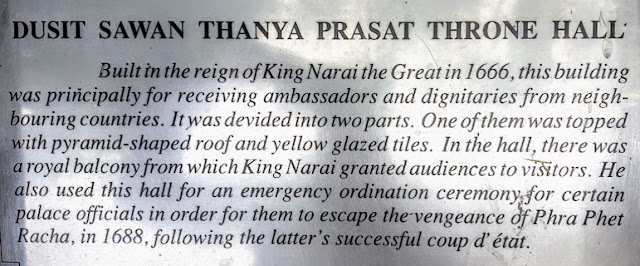 |
| Prang Sam Yot & its monkeys |
The historical city of Lopburi is at about 150km north of Bangkok. It is the capital of a Thai province and is crossed by a river. Both the river and the province bear the same name as the city.
The town itself is rather big and is reported having more than 750,000 inhabitants. But apart from a large avenue punctuated by monumental roundabouts, the modern city has not much to offer.
 |
| Sitting Buddha at Prang Sam Yot |
Nevertheless, there is a historic section, near the downtown railway station, that is worth seeing. But as monkeys are part of the old Indian legend of King Rama and Hanuman, the monkey god, expect to see herds of macaques in this area! It may look exotic at first sight, but it soon turns to be a real nightmare! Besides the noise they make, the dirt they bring, they soon become a nuisance as they can easily turn aggressive. You wonder how the shopkeepers in the area can cope with this simian crowd!
Needless to say though that they are the main town entertainment! After all, this is a touristic curiosity that brings fame to the otherwise sleepy town.
Lopburi is over a thousand years old. It used to be a regional capital of the Khmer Empire. The best reminder of the Khmers is a site called Prang Sam Yot (12thcentury), which has been nicknamed 'the Monkey Temple'. Guess why? In Thai, the name speaks for itself as it means 'the three (sam) spires (prang) mounts (yot)'. In the Khmer architecture, a prang[ปรางค์] is tall rounded spire richly carved. If you are familiar with Angkor Wat, then you know what this is.
In the centre of the nearby roundabout, there is a Thai shrine (San Phra Khan) that attracts local worshippers...as well as a few daring monkeys, which are quickly chased away.
The rest of this downtown section is rather commercial and offers no specific interest, apart from a
 |
| Inner gate at King Narai's Palace |
few vestiges here and there.
The main interest in the town is the former residence of a 17thcentury Thai King in the same area as the railway station. Phra Narai (1656-1688) enjoyed the mild climate of the region so much that he decided to have his second residence built here. This happened at the time of the Ayutthaya Kingdom when Siam was opening up onto the World. So, King Narai requested the help of French architects for the building of his royal residence, Phra Narai Ratcha Niwet. This refers back to an interesting episode of Thai history with King Louis XIV of France. Lopburi became the second capital of the Siamese Kingdom. In 1685, King Narai greeted the French embassy at the Lopburi Palace.
The royal residence welcomes visitors. Open gardens, courtyards and buildings turned into museums make it a great place to visit to know more about this period of Thai history.
Christian Sorand
























No comments:
Post a Comment